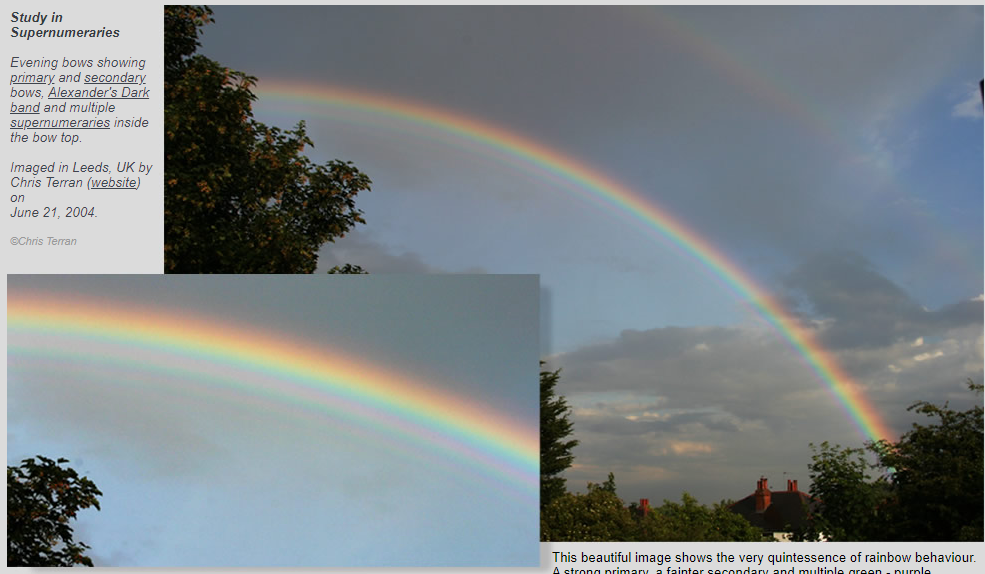Why do we see supernumeraries at a bow's top?
Why do we see supernumeraries at a bow's top?
When we look at a rainbow, we often notice a phenomenon known as supernumeraries. These are additional bands of colors that appear inside the primary rainbow. Interestingly, supernumeraries are most commonly seen at the top of the rainbow. But why is that the case?
One factor that contributes to the presence of supernumeraries at the top of a rainbow is the wide range of sizes of raindrops that form the rainbow. Paradoxically, this variation in drop size actually helps create clear supernumeraries at the bow's top. As raindrops fall, they become slightly flattened, and the rays of light passing through these flattened drops form the top part of the rainbow. The combination of flattening and the variation in supernumerary spacing with drop size leads to a persistent fringe spacing of approximately 0.7° when the drop size distribution is broad.
As we move lower down the bow, the rays passing through the larger flattened drops cross them in planes that are only slightly tilted from horizontal. In these angles, the cross sections of the drops are more circular, and the effect of producing supernumeraries no longer operates. The wide variety of drop sizes then results in a range of supernumerary spacings. The supernumeraries overlap, and we only see the primary bow with enhanced brightness inside.
On the other hand, when the raindrops are smaller and less diverse in size, the spacing of supernumeraries becomes more dependent on drop size. This can be observed in the complex rainbow display at Statesville, North Carolina, where the supernumeraries appear in a more intricate pattern.
In summary, the presence of supernumeraries at the top of a rainbow is influenced by several factors:
- Wide range of raindrop sizes: The variation in drop size helps produce clear supernumeraries at the bow's top.
- Flattening of raindrops: As raindrops fall, they become slightly flattened, and the rays passing through these flattened drops form the top part of the rainbow.
- Variation in supernumerary spacing: The combination of flattening and the variation in supernumerary spacing with drop size results in a persistent fringe spacing of approximately 0.7° at the bow's top.
- Circular cross sections: As we move lower down the bow, the rays passing through the larger flattened drops cross them in planes that are more circular, reducing the effect of producing supernumeraries.
- Overlapping supernumeraries: When there is a wide variety of drop sizes, the supernumeraries overlap, and we only see the primary bow with enhanced brightness inside.
- Dependent on drop size: When raindrops are smaller and less diverse in size, the spacing of supernumeraries becomes more dependent on drop size, resulting in a more intricate pattern.
Understanding why we see supernumeraries at the top of a rainbow adds to our appreciation of the complex behavior of light and water droplets in the atmosphere. The interplay between drop size, flattening, and the resulting variation in supernumerary spacing creates the stunning visual phenomenon that captivates our eyes and sparks our curiosity.
Study in Supernumeraries
Evening bows showing primary and secondary bows, Alexander's Dark band and multiple supernumeraries inside the bow top.
Imaged in Leeds, UK by Chris Terran (website) on
June 21, 2004.
©Chris Terran

This beautiful image shows the very quintessence of rainbow behaviour. A strong primary, a fainter secondary and multiple green - purple supernumeraries crowding inside the upper part only of the primary. Why do we see supernumeraries most often at the top of a bow?
Often the raindrops forming the rainbow have a wide range of sizes. Paradoxically, this can help produce clear supernumeraries at the bow top. The larger raindrops are slightly flattened as they fall and rays forming the rainbow top have to pass through their flattened vertical cross-section. It so happens that the combination of flattening and the variation in supernumerary spacing with drop size produces a persistent fringe spacing of ~0.7° when the drop size distribution is very broad.
Lower down the bow, rays passing through the large flattened drops cross them in planes only slightly tilted from horizontal. At these angles their cross sections are more nearly circular and the effect no longer operates. The wide variety of drop sizes then produces a range of supernumerary spacings. The supernumeraries overlap and we see only the primary bow with enhanced brightness inside.
When the raindrops are smaller and less diverse in size, the supernumerary spacing does depend on drop size as seen in the complex rainbow display at Statesville, North Carolina.
Note: this article has been automatically converted from the old site and may not appear as intended. You can find the original article here.
Reference Atmospheric Optics
If you use any of the definitions, information, or data presented on Atmospheric Optics, please copy the link or reference below to properly credit us as the reference source. Thank you!
-
<a href="https://atoptics.co.uk/blog/why-do-we-see-supernumeraries-at-a-bows-top/">Why do we see supernumeraries at a bow's top?</a>
-
"Why do we see supernumeraries at a bow's top?". Atmospheric Optics. Accessed on November 26, 2024. https://atoptics.co.uk/blog/why-do-we-see-supernumeraries-at-a-bows-top/.
-
"Why do we see supernumeraries at a bow's top?". Atmospheric Optics, https://atoptics.co.uk/blog/why-do-we-see-supernumeraries-at-a-bows-top/. Accessed 26 November, 2024
-
Why do we see supernumeraries at a bow's top?. Atmospheric Optics. Retrieved from https://atoptics.co.uk/blog/why-do-we-see-supernumeraries-at-a-bows-top/.